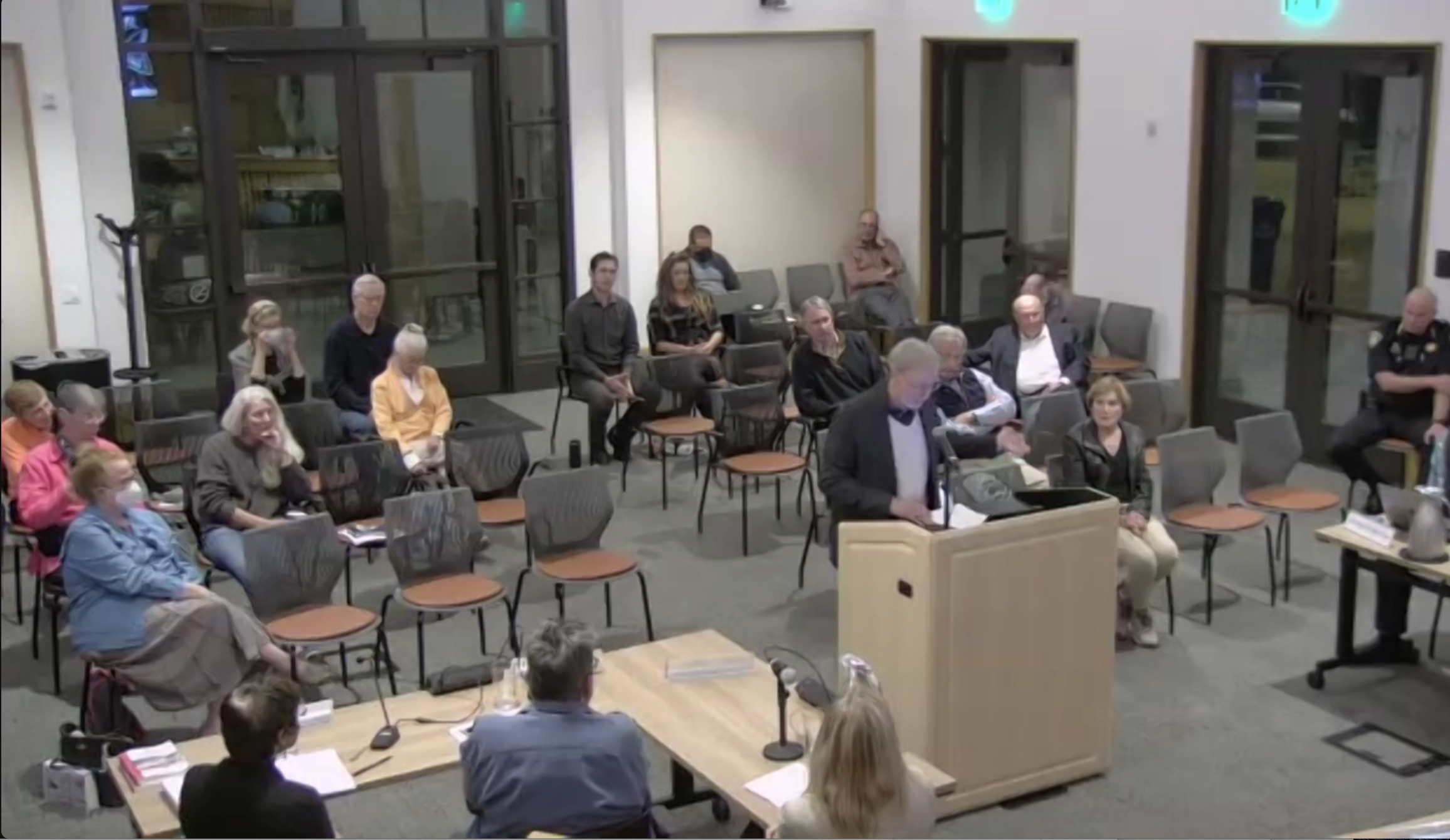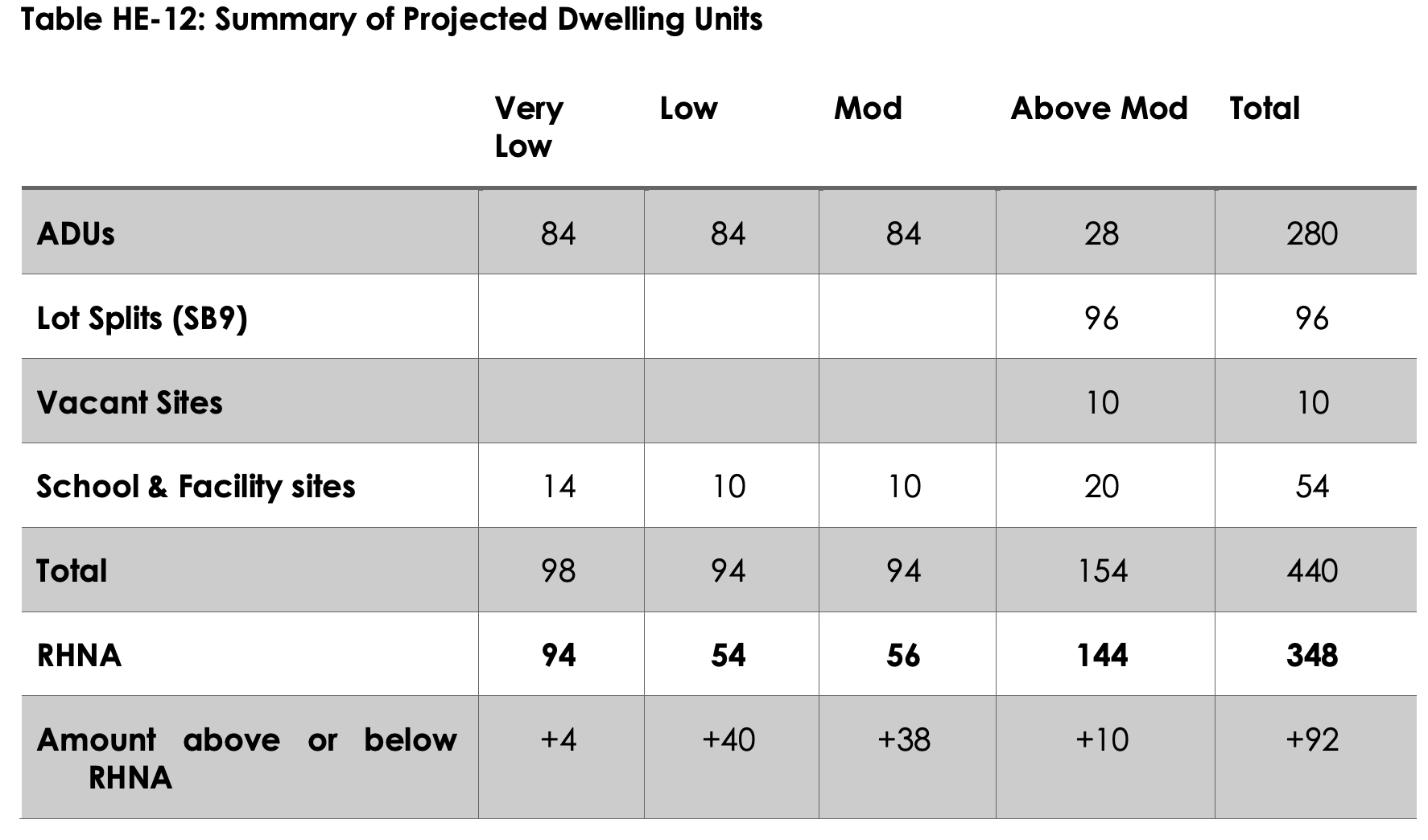With feedback from the state on its draft housing plan weeks away, the Atherton City Council hosted a community meeting on the topic on Tuesday, Oct. 11, to gather feedback from residents and get more details on what's to come in the process. Some residents urged the town to devise a Plan B now, others expressed fears about the town changing if multifamily housing is built and a former mayor even dared the officials to go denser in their plans.
The town is set to get feedback on its Regional Housing Needs Allocation (RHNA) plan from the state's Department of Housing and Community Development (HCD) in late October or early November. The town is tasked with planning for 348 new housing units from 2023 to 2031, a substantial jump from the previous RHNA cycle.
The draft housing element approved by the City Council went with a growth plan that leans into accessory dwelling units (ADUs) — 280 units — over multifamily housing.
Former Atherton Mayor Jim Janz said he fears ADUs are not going to cut it.
"I'm going to make a small pitch to not be afraid of density," he said. He said he grew up in northwest Indiana in a single-family home next to a four-story apartment building.
"It was no big deal; it was right next door," said Janz, who served on the council until 2008 and is a member of the town's Rail Committee. "If you had a pool in your yard you couldn't lay out in the nude. …. It didn't destroy the neighborhood. … You might consider something a little denser here and there. You don’t have to go to 20 units per acre."
Alameda is the only Bay Area city of 15 that have received feedback from the HCD to be approved, according to The Mercury News.
Fears about what will happen to Atherton if it's developed further, calls for backup plans
One resident, Debra Holvick, is fearful about how the town will be affected by crime if affordable housing is built in town.
"This is very scary what’s going on," she said. "There's a lot of crime with low income people. … Has there been any consideration for infrastructure or traffic? … I don't know who's behind this. I don't know why HCD suddenly decided we had to put in millions and millions of more houses in California."
Town consultant Diana Elrod explained to Holvick that families of four making less than $90,000 qualify for low-income housing and that low-income families are not necessarily homeless people.
"We're not talking about people who make no money, we're talking about working people," she said.
Others are concerned that if the town doesn't have a backup plan now, it will be left scrambling if the state rejects its draft plan. Resident Ann Walker suggested the town rezone the fringes of town, along the border of Redwood City, for multi-occupancy housing.
"There are multiple places where we could put multiple townhouses," she said. "It wouldn't change the nature of the whole neighborhood. … California has a huge housing problem. We need to be more realistic."
Others asked the City Council to not push the development onto the borders of town.
Jim Massey of Lloyden Park said multifamily development along El Camino would destroy property values in that area.
One worried about where people would park if there were more homes in town.
ADUs
Because the town is leaning into ADUs so heavily in the plan, Town Planner Lisa Costa Sanders said the town is considering several changes to help encourage their production.
These are the methods the town is looking at:
• Pre-approved ADU plans
• Planning review fee waiver
• Amending its code to allow conversion of guest houses to ADUs
• Consider amending code to allow two ADUs per property
• Develop ADU resources to assist property owners to develop ADUs
• Partner with local organization to assist tenant matching
Cities in the state will likely be required to survey actual ADU production and rents every two to four years as part of their RHNA plans, Elrod said.
Jeremy Levine of the housing advocacy group the Housing Leadership Council said that he didn't think the town's 280 ADUs in the plan seems reasonable. He warned the town that it's "very risky" to not have a backup plan when with an ADU-only strategy without supporting evidence that these units can be built.
Levine said that it's hard to imagine more than 10% of town's homeowners will become landlords.
"Most residents don't need rental income," he said. "It may be charity in people's hearts but it's a pretty monumental task."
The town is asking residents to take this ADU survey as part of the housing element process.
What could happen if the town doesn't comply
Consultant Barbara Kautz of Goldfarb & Lipman said the town could face fines of $10,000 to $600,000 per month if it doesn’t adopt a state-approved housing element plan.
"It's highly unlikely the state will approve it without any multifamily zoning," she said. She noted the schools' multifamily housing plans may be too vague to satisfy HCD. "San Mateo, which is a relatively pro-housing city, got a 14-page letter (from HCD with feedback on its housing element), which is the most incredibly nit-picky thing I can imagine."
HCD now has a proactive enforcement team.
View the draft plan here.






Comments
Registered user
Menlo Park: The Willows
on Oct 13, 2022 at 12:06 pm
Registered user
on Oct 13, 2022 at 12:06 pm
Density, properly sited, can be good. We'll never have good public transportation without a little more density. Although I don't know where it should be built, I can imagine an attractive neighborhood of town houses in Atherton. Being in Atherton, they are unlikely to be affordable to most, but any increase in the supply of housing in this area would be beneficial.
Registered user
Menlo Park: Downtown
on Oct 13, 2022 at 12:11 pm
Registered user
on Oct 13, 2022 at 12:11 pm
Menlo Park is facing the same challenges, but there it has been politicized into a question of teacher housing. However, at the end of the day it is almost a philosophical question. Should we accept changing the fabric of existing single family neighborhoods in order to increase housing?
People cheering this on, beyond the obvious developers, obviously can't afford to live in these neighborhoods, which in itself is sad but part of our market economy system. Perhaps it would make more sense to increase density around major arteries that is built for the traffic, and has public transport and other infrastructure, as opposed to residential areas with a high density of kids playing on the streets?
Registered user
Menlo Park: Suburban Park/Lorelei Manor/Flood Park Triangle
on Oct 13, 2022 at 12:56 pm
Registered user
on Oct 13, 2022 at 12:56 pm
About that, I'm living in a very nice house that I think you might have sold me.
I *can* afford to live in a single-family neighborhood. And I'm acutely aware of how bad it is for our region when the people who keep our wealthy community healthy, educated, fed, vibrant, safe, and interesting are all having to spend hours commuting every day. I'd think the realtors would be taking a longer-term view on this and looking for creative solutions.
Taking a vacant lot that was never a single-family home and turning it into apartments doesn't diminish the single family homes nearby –- and it doesn't change the traffic in any significant way. It just means some of the people driving on our streets from places like Morgan Hill and Manteca to get to work now have much shorter commutes.